|
Printables |
PowerPoints |
Online exercises |
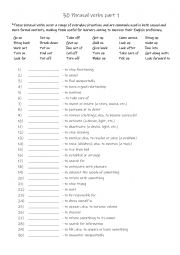
|
30 Phrasal verbs part 1 a
These phrasal verbs cover a range of everyday situations and are commonly used in both casual and more formal contexts, making them useful for learners aiming to improve their English proficiency; they are suitable for CEFR A2-B1 levels. Students match the phrasal verbs to their definitions. Answers on page 2. All of the phrasal verbs used in this ...
Level: elementary
Age: 10-100
Type:
Downloads: 119
|
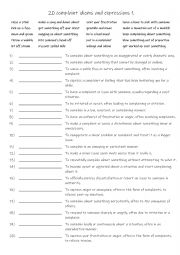
|
B1+-C1 20 complaint idioms and expressions 1
First, students need to familiarise themselves with the 20 idioms and expressions and their meanings. Then they read the definitions to see which one is being described and write that word in the space provided Answers on page 2.
Level: intermediate
Age: 12-100
Type:
Downloads: 104
|
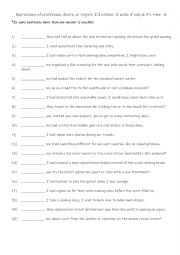
|
A2-B1 Expressions of preference, desire, or regret I�d rather, I wish, if only & it�s time 4
Students should learn expressions of preference, desire, or regret like "I�d rather," "I wish," "If only," and "It�s time" because they help them communicate personal feelings, make choices, and reflect on past experiences or future possibilities in English. These phrases allow students to express what they want, what they regret, or what they feel...
Level: elementary
Age: 10-100
Type:
Downloads: 159
|
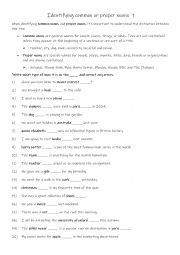
|
Identifying common or proper nouns 1
First, students need to familiarise themselves with the 2 types of nouns. Then they read the sentences to identify and use the correct punctuation for all of the sentences. Answers on page 2
Level: elementary
Age: 9-100
Type:
Downloads: 111
|
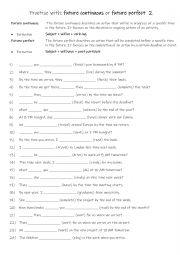
|
A2+-B1 Practise with future continuous or future perfect 2
Students should learn the future continuous and future perfect tenses as they are essential for discussing future actions with precision. The future continuous is used to describe actions that will be in progress at a specific time in the future, making it ideal for expressing plans, predictions, or expectations (e.g., This time tomorrow, I�ll be t...
Level: elementary
Age: 9-100
Type:
Downloads: 102
|
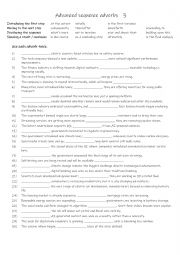
|
7 Advanced sequence adverbs 3
First, students need to familiarise themselves with the 7 adverbs. Then they read the sentences to work out which one is needed to complete the gap-fill. Each adverb is used 3 times! Answers on page 2
Level: advanced
Age: 12-100
Type:
Downloads: 130
|
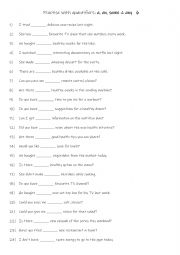
|
A1-A2 Practise with quantifiers a , an , some & any 6
Mastering these basics is essential for both everyday communication and more advanced language use, as these quantifiers are frequently used in real-life scenarios like offering, requesting, or describing items. First, students need to familiarise themselves with 4 quantifiers and check their meaning and use. Then they read the sentences to see whi...
Level: elementary
Age: 7-100
Type:
Downloads: 118
|
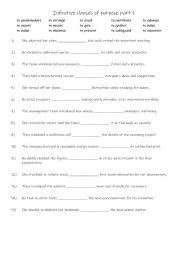
|
B1+-B2 15 infinitive clauses of purpose Part 1
Infinitive Clauses of Purpose are used to explain the reason for or purpose of an action. These clauses are often introduced by the infinitive form of the verb ("to" + verb) and provide clarity and directness to communication. Learning to use infinitive clauses correctly helps you express intentions in a precise and formal manner. Infinitive clause...
Level: intermediate
Age: 10-100
Type:
Downloads: 115
|
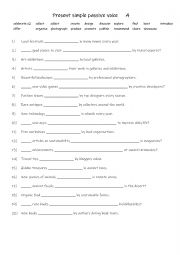
|
Present simple passive voice 4
Learning the present simple passive voice helps students focus on the action or the recipient, rather than the doer. It�s useful when the doer is unknown, unimportant, or to emphasize the object. Mastering this structure improves clarity, variety in sentence construction, and is essential for formal or academic communication. Students complete the ...
Level: elementary
Age: 9-100
Type:
Downloads: 126
|
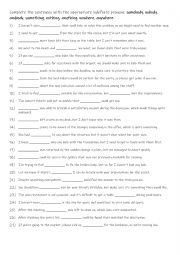
|
B1-B2 Indefinite pronoun: somebody, nobody, anybody, something, nothing, anything, nowhere, anywhere.
Students read the sentences and complete the gap-fill with a suitable indefinite pronoun. Answers on page 2.
Level: intermediate
Age: 10-100
Type:
Downloads: 134
|
|
|
|
|












